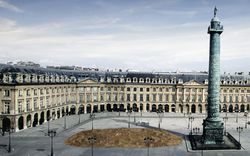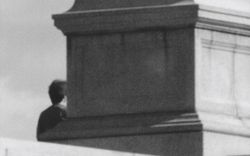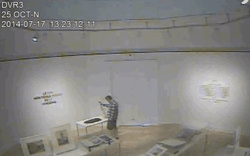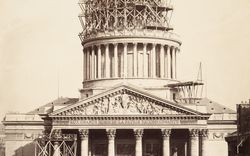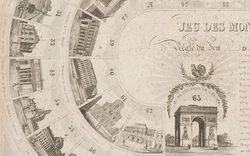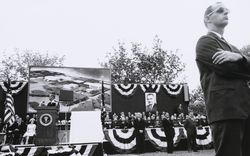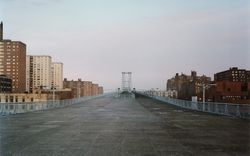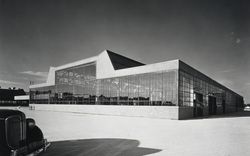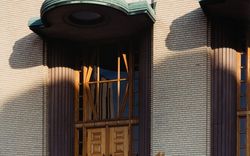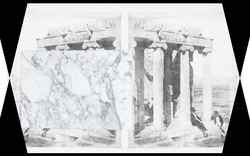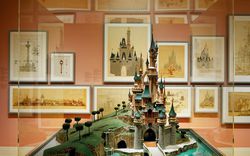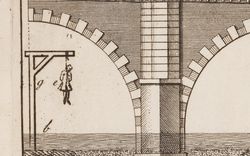Power Pictures: The Visual Rhetoric of the US Presidency
Text by Ulrich Keller
In the last two hundred years, American political leadership has largely been exerted through the word, rendering speechmaking by legislators and presidents the principal focus of political reportage. For the sake of simplifying a complex subject, this article will concentrate on presidential speech as a sort of leitmotif in addressing the question of how the gradual visualization of political speech (i.e., its transformation from a literary to a visual genre) in the pictorial mass media has fundamentally changed—more precisely: masked and disciplined—the political process, not just since the advent of television, as most relevant studies seem to assume, but beginning with the rise of the illustrated daily and weekly newspapers almost a century earlier. The powerful effect of the early picture press on American politics can be strikingly demonstrated by comparing the following speech events from two different historical eras.
Around 1800, reporting presidential speech was a purely literary affair, as shown by a broadsheet of Thomas Jefferson’s first inaugural speech peddled in the streets on inauguration day. Remarkably, no pictorial reportage survives of the first ten inaugurations; what counted then was the printed word, not the visual appearance. Abraham Lincoln could still afford to wear crumpled suits and sweat-soaked shirts without detriment to his career, but with the rise of the picture press following the Civil War, the visual dimension of presidential speech began to compete with its literary side. By 1907, the tradition of presidential words without pictures was answered by occasional publications of presidential pictures without words, as this spread from Harper’s signals. The photographs are sequenced into a complex visual discourse which begins with the opening statement of a full-face portrait, ends in an exactly corresponding, concluding shot of the back of Roosevelt’s head, and for the rest consists of profile views symmetrically answering each other. We are dealing here with an early example of sophisticated and entertaining picture editing which in the early 1900s was beginning to generate a previously unknown type of aesthetic spectacle on the printed page. What Theodore Roosevelt actually said on the speech occasions documented here is not revealed to the reader and does not seem to matter any more. Roosevelt knew that; his theatrical oratory deliberately pandered to the press cameras.1
Read more
The pictorial press not only visualized and dramatized presidential speech, it also greatly increased speech frequency. For example, for more than a hundred years, presidential messages had been sent as written documents from the White House to the Capitol until Woodrow Wilson decided to address Congress in person in a dramatic appearance designed to hit the front pages of the newspapers. Already forty years earlier, in the first sophisticated visual media campaign to win the White House, Horace Greeley had dramatized his notification of the Democratic candidacy for president with a public ritual prominently covered by the fledgling picture press, whereas previous notifications had been done by mail. We need to remember here that in the early republic, political oratory was principally suspect; it raised the spectre of demagogic, dictatorial subversion of the polity, and thus the first presidents resorted to it only on rare occasions, mostly inaugural. Vote solicitation during election campaigns was considered especially loathsome; presidential candidates stayed at home and remained silent.2 However, by the late nineteenth century, the new pictorial press, combined with conventional though improved literary reportage, placed a communication apparatus of such enormous mass appeal at the disposal of candidates for the highest office that the question became not whether but how it would be exploited for political purposes.
For the purposes of the present brief survey it is not necessary to trace the incremental changes in the political instrumentalization of this apparatus. Suffice it to say that the election of 1896 marks the advent of the full-fledged “modern” mass media campaign. True, in keeping with the dignified front-porch tradition, the Republican candidate William McKinley stayed at home, but at enormous expense seven hundred and fifty thousand Republican partisans were shipped to Canton, Ohio, by rail and marched morning to evening to greet the candidate at his home. He received them with a two-pronged media strategy. Verbally he responded to the various groups with carefully prepared addresses that thematized their diverse regional and social interests. Visually he was equally effective, posing with every delegation for cozy “family photographs” and surfeiting the press with further illustrations for biographical picture stories, while a huge campaign budget was used to print millions of pamphlets and vividly coloured posters.
His opponent, William Jennings Bryan, entered the race with a radical agrarian agenda anathematized by the business establishment, which forced him to run a shoestring campaign without financing to speak of. His situation would have been hopeless had he not been the greatest orator of his generation. In an incisive break with tradition, he decided to make speech his main campaign weapon and embarked on a massive “stump” campaign throughout the country. Bryan travelled eighteen thousand miles, gave six hundred speeches, and met in person an audience of five million Americans. The papers ridiculed his politics, but wherever he went he was an instant sensation and pictures of his charismatic appearances crowded the front pages. The example illustrated here is a line engraving based on a drawing by a picture reporter or “special artist” of the New York Herald. Bryan’s major speeches were often captured by dozens of such quick eyewitness sketches spread over a whole page, and they contributed a great deal to his charismatic appeal. Contrary to prevailing assumptions, picture publicity had become a major factor in American politics years before photographic halftone illustrations conquered the newspapers. Officially, Bryan always maintained that the campaign of 1896 was about issues, not personalities, but he was astute enough to capitalize on the new opportunities offered by the picture press. His suave, well-groomed speaking style powerfully appealed to the eye as well as to the ear, and even minor details of his delivery made visual news.3
While this emerging sphere of political spectacle offered significant publicity benefits, it also presented new problems of message control. In the times of Abraham Lincoln and Andrew Jackson, as long as the presidency was a literary construct, such problems were marginal.4 A speech was carefully redacted for publication, sometimes with the help of ghost-writers, and verbatim regional diffusion was guaranteed by small newspapers owned by the political parties. Since reportorial staffs did not exist as yet, no independent critical checking of facts and background information was to be feared; the papers were sure to bash the opposing party’s newest speech, no matter what it said. However, by 1900, mass-circulation newspapers with their own corps of reporters and photographers emerged. The press had become an independent power, subjecting politics to critical, increasingly visual surveillance, and forcing politicians to vie for press attention—sports, theater, sex, and crime being the main competitors.
The political establishment responded by monitoring its own appearance in an internal, behind-the-scenes process of self-control and strategic planning. Presidential candidates started meeting with handlers and advisors in smoke-filled back rooms to make their appearance safe and attractive for press reportage. Bryan had such handlers in 1896, and even though their strategy meetings were not designed for press coverage, an occasional picture would reach the printed page at a time when any publicity was beginning to be seen as good publicity. Thus a cleavage opened between Bryan, the charismatic evangelist, and Bryan, the political schemer, and this cleavage became a constitutive feature of twentieth-century American politics. The real political decisions were henceforth made backstage, while smoothly aestheticized political theater for camera coverage was put on the front stage. Pictorial reportage forced presidential politics to mask itself, to acquire a cosmetic facade. It is no accident that at the Democratic Party convention of 1896 the Nebraska delegation vied for visual publicity by marching into the hall with unison “Bryan” haircuts, while the always impeccably groomed McKinley figured in shaving commercials.5
More than that, the structure of speech itself changed. Formal oratory, in one-to-two-hour formats loaded with programmatic content, lost ground to informal, chatty retailing of presidential small talk by way of (frequently illustrated) interviews in the entertainment-oriented metropolitan papers, the ground rules of which were being defined in an ongoing power struggle between press and politicians. The most fundamental innovation of the time consisted, however, in the supplementation of verbal presidential speech, formal or informal, with a range of non-verbal, purely visual rhetoric. American presidents and presidential candidates began to be known primarily not for their words and political beliefs (which continued, of course, to be publicized in formal speeches), but for their daily habits, such as reading books, playing golf, trout fishing, and so on. Wilson was marketed in this way during a campaign and won with the help of primary votes against the party establishment.6 This human interest aspect of the presidency began to dominate the newspapers with the rise of photojournalism and can perhaps best be summed up as a victory of the smile over programmatic declaration. Up to the time of McKinley, it is impossible to find images of smiling presidents. Theodore Roosevelt used his irrepressible hilarity as a publicity tool, and very soon constant smiling became not only typical of the office, but a prerequisite for obtaining it; without virtuosity in this art of physiognomic masquerade elections could not be won any more.7 In keeping with the available still camera technology, such publicity efforts were content with momentary snapshot effects, rather than the long-term narrative scenarios with which modern television audiences are familiar.
The advent of the newsreel did not significantly change the staccato rhythm of the photographic coverage; newsreels showed presidents only in brief picture sequences, either speaking or in some sort of customary (rather than newly scripted) ceremonial action, and thus they overlapped substantially with snapshots of the same events on the printed page. In the 1930s, presidents continued to be groomed for momentary exposure—they smiled, shook hands, and cut ribbons more photogenically than ever. Meanwhile, however, the downsizing of presidential speech into smaller and more marketable units continued. Leaving aside the non-visual innovation of political speech broadcast by radio in increasingly informal and even intimate formats, such as Franklin Delano Roosevelt’s famous “fireside chats,” the eternal sparring between press and presidents over interview rules resulted, under the Democratic Roosevelt, in the establishment of the bi-weekly press conference. This institution conceded to the press constant access to the president and a quasi-constitutional right to critical review of the current political affairs as articulated by the chief executive.8 Precisely because of this institutionalization, though, no major newspaper could absent itself from the information rituals, and this gave Roosevelt considerable leverage in changing the ground rules to the point of unofficial censorship. Reporters who broke rules were excluded from press conferences and Roosevelt’s retinue when he travelled, putting the respective newspaper at a great competitive disadvantage. Thus it was possible, for example, to hide from the nation the president’s physical handicap; the press corps knew about it and a few photographs documented his condition, but with rare exceptions, these images were never published by the papers.9
While the impact of the newsreel remained surprisingly modest in the period between the World Wars, the rise of television since the 1950s, of course, prompted an incisive reorganization of presidential speech reportage. Major new developments included the scripting of extended political speech and action scenarios, the concomitant growth of humaninterest elements, the shrinkage of programmatic speech from sixty- or thirty-minute formats to ten-second soundbites, the progressive elimination of press access to and critical review of presidential government, and the extension of visual control from the political actors to the live, local audiences before the cameras.10
In this new media environment, John F. Kennedy was in many ways a less revolutionary figure than one might expect. True, press conferences now became a genre of live television spectacle, and in contrast to his forerunner Adlai Stevenson, who remained wedded to the pen and the hopelessly outdated tradition of formal, substantive, personally authored speech, Kennedy proved to be a splendid impromptu performer, and he knew that programmatic politics was a thing of the past. When he said in his inaugural address that “the torch has been passed,” he did not announce a concrete political agenda, but consciously and cunningly appealed to dream and desire—providing a rich topic to the pop artists. Rosenquist painted the president-elect, before he assumed power, in a state of innocence, unsoiled by the Bay of Pigs, as pure future hope and consumer dream, whereas Rauschenberg paid homage to the president in memoriam, as pure past and popular legend, a hero of the last, imaginary frontier in space.11 The interval between these prospective and retrospective evocations, the place of actual politics, remained empty. We have an early instance here of critical observers pointing to the loss of the referent in the increasingly dizzying manipulation of political signs.
The real Kennedy who filled the thousand-day period between these pictures was, on the bottom line, a liberal who still saw the press as the quasiconstitutional power it had become under Roosevelt, at the least. He entertained, cajoled, and sparred with the reporters, but so had Wilson and the two Roosevelts. To him, the print and television media always remained an opposite and independent power to be respected and persuaded, but such clear-cut division between political acting and journalistic reporting was quickly turning into a pious notion of the past, as Carry Winogrand underscored in intelligent snapshots which amount to a little theory of 1960s mass communication. In a photograph of Kennedy’s 1960 acceptance speech in the Los Angeles Coliseum, the Democratic nominee speaks directly into a forest of cameras, which practically block out any trace of the live, local audience. Kennedy the man addresses the crowds and the reporters opposite him—but in addition there are media functionaries who observe, monitor, and control Kennedy the television image from behind.
The television screen had become the measure of all things political, and effective screen performance enforced an increasingly close, but opaque, symbiosis between the political actors and the camera teams. In the process, any direct, personal, spontaneous interaction between the candidate and the people got lost, too. Where Bryan had needed hundreds of speeches and months of travelling to address in person five million Americans, Kennedy was able to reach tens of millions in one evening—at the price of reducing the locally present audience to a mere decorative backdrop for a grand television spectacle orchestrated in media control rooms. Such rooms opened a murky arena full of opportunities for the media to hijack politics and for politicians to hijack the media. Winogrand emphasized the first option in his snapshot of a Vietnam rally where it is impossible to tell apart the presumably impassioned demonstrators from the supposedly impartial, distanced media representatives; clearly, the still and television cameras produced this event as much as they recorded it. Yet if the press has hijacked the political process here, it was the reverse pattern of the politicians hijacking the press that proved to be historically most relevant, and the perfection of this technique is owed to Richard Nixon.
Already in the late 1950s, Nixon made masterful use of a press camera by nailing Khrushchev in the famous “kitchen debate.” This was not an example of critical journalism; instead, the camera was cleverly used as an accomplice in a political ambush. Later, as president, Nixon scripted for television coverage entire narrative scenarios, including his own resignation, and such scripting has become standard since. Also as president, Nixon abolished regular press conferences and often reduced his interaction with the media to the reading of sixty-second messages that could not be edited and had to be broadcast entirely or not at all. Nixon thus pioneered “soundbite” politics and accelerated the Vietnam-era erosion of the press as an independent, critical power. During the 1968 campaign Nixon essentially became his own television producer when he filled sixty-minute slots bought at enormous expense with “news” footage shot by his own camera crew. Such commercially manufactured media packages included his triumphal entry into town-and-panel discussions with panellists selected by Nixon’s own managers—while the campaign press train was herded into an adjacent room, able to watch on screen, but unable to witnesses firsthand and put their own questions to Nixon.12
Obviously, the balance between political action and press reportage is here rearranged much to the advantage of the latter: politicians begin to produce their own television coverage, acquiring control over the press apparatus and even over the audience—a rather new feature. As to visual audience control, we know that wherever Nixon made a televised appearance, his media specialists guarded the entrances and denied admission to any unsavory looking fans, especially those with long hair and dark skin. This is not always easy to document in pictures, but a comparison between reportages of the Democratic and Republican national conventions of 1968 is striking enough. The Democrats in Chicago allowed the press to hijack the convention in pictures that look like Winogrand translated into color and prove that nobody guarded the doors to screen out dark skin. Nixon, on the other hand, had a very enjoyable week in Miami, framed as a happy and lily-white family affair.13
To elaborate on this new art of audience control: nineteenth-century inaugurations involved much parading, cheering, and popular excitement around the presidential stand. Yet by the time of Lyndon Baines Johnson’s induction into office in 1965, it had become customary to build stalls that locked all spectators into place and produced totally controlled visual results. Remarkably, the large audience groups in the seat rows below and in front of the presidential stand were forced to turn their backs on the inauguration ceremony, looking instead into the television cameras for enhanced cosmetic effect. Such reportage aims at the totalization of control—not only do the political actors begin to produce their own shows, with the presumably independent broadcasting corporations left to deliver to the nation a ready-made public relations package; but in symbiosis with the press apparatus, the political establishment also begins to deny to the electronically mediated public any independent, critical reaction. The token, cosmetically groomed, local audience before the camera stands in for the nation as a whole and mirrors for the national audience before the television screens the docility with which the televised event wants to be watched: as a dazzling, one-way spectacle. Bill Clinton later proved particularly adept at inserting political performance into talk show formats where the token local audiences are conditioned to applaud on cue, either by electronic prompting, or by internalized habit.14
Further progress was made in television and audience control by Ronald Reagan and the Bushes. The Republican national convention of 1984 set new standards in the skillful electronic interweaving of geographically and categorically unrelated actors and audiences.16 Via television cameras and choreographic arrangements controlled by the Republican Party, rather than a commercial network, Ronald’s huge, flat screen apparition is greeted by the diminutive but “real” Nancy with a loving salute to her personal hero. What this particular shot does not feature, but can be mentally supplied and was shown on television, is the fact that Nancy acts here as the lieutenant of the Republican convention delegates at large who crowd the seats right in front of her and are encouraged by her example to look up to their party chief with equal affection. Thus the president’s image is positioned to arrive at its final destination, the millions of American living rooms, doubly filtered and doubly charged with positive emotion, making it difficult for the nation to exclude itself from the closed-circuit Republican love fest. Minimal trace elements of presidential speech completely dissolve here into the visual scenario, and increasingly rare instances of critical commentary by television correspondents are neutralized by the powerful visuals that simply “swamp” the words.16
Of course, this is not to say that the media have become docile tools of political manipulation tout court. Undoubtedly, television was a key element in ending a Vietnam War to which the White House was fully committed, and the recently surfaced pictures of the Abu Ghraib prison abuses have once again demonstrated the power of the visual media to undermine presidential pro-war propaganda. However, in these instances, the image sources escaped the control of the politicians, be it due to management lapses, lagging media sophistication, or pure accident; even the most consummate political manipulators will never be able to eliminate disruptive factors of this kind. By contrast, this article foregrounds the issue of presidential news of the kind usually planned and often shot in the White House itself, which is able to monopolize, stage, and produce such news under any rules and conditions it wishes to impose. In this special arena of media management, unforeseen disruptions can be minimized, and the best talent in the land is available to take television manipulation to ever-higher levels of refinement.
To briefly cite one last example: in a step beyond Reagan, the first Bush administration was prompted by the first Gulf War to perfect the interweaving of geographically and socially separate constituencies into a synthetic telecommunity on a global, rather than just regional, scale. The twenty-minute halftime show during the 1991 Super Bowl transmission fused fifty thousand football fans in a Texas stadium, George Bush in the White House, the GIs in their Arabian desert bunkers, and one hundred million Americans in front of their television sets from Florida to Alaska into one great patriotic family nexus—a reassuring, electronically simulated sphere of the “us” which blocked out any thought of “them,” the victims of the war. Underpinned by the president’s soothing words, the civilized, purely symbolic, quintessentially American and therefore justified sports competition was virtually enlarged to cradle everything else in its ample lap, proving the moral superiority and peaceful orientation of American culture. The boys had not really left home and the savageness of war, the straying precision bombs and the dying Iraqi children, remained invisible on the Other side of the television extravaganza.17
In short, during the last thirty years or so, the American presidency has given top priority to the production of moving television stories about itself, making discursive speech progressively expendable. The presidency is on its way to become a completely watertight, self-referential, pictorial system, a family affair between husbands and wives and fathers and sons, with the general public electronically constructed and plugged in as a loving, extended family. It seems entirely possible that this system can insulate itself from external turbulences to the point that for the rest of American history one Bush will follow another—and the visual glory of the nuclear sunset will richly recompense us for the demise of political discourse and reportage worthy of the name.
-
The rise of the pictorial presidency can be traced in numerous publications, such as Stefan Lorant, The Glorious Burden: The American Presidency (New York: Harper & Row, 1968) and Arthur M. Schlesinger, ed., Running For President: The Candidates and Their Images, 2 vols. (New York: Simon & Schuster, 1994). For the rise of the picture press specifically, see Ulrich Keller, “Photojournalism Around 1900: The Institutionalization of a Mass Medium,” in Shadow and Substance: Essays in the History of Photography in Honor of Heinz K. Henisch, ed. K. Collins (Bloomfield Hills, MI: Amorphous Institute Press, 1990), 283ff. ↩
-
Wilson’s Congressional appearance was illustrated in Harper’s Weekly on 19 April 1913. For Greeley’s notification, see the woodcut in Leslie’s Illustrated Newspaper, 3 August 1872; Lorant reproduces it in The Glorious Burden, 322. The rhetorical reticence of the early American presidency and the gradual increase of presidential speech under constant accusations of demagoguery are discussed in Marvin R. Weisbord, Campaigning for President: A New Look at the Road to the White House (Washington, DC: Public Affairs Press, 1964) and Jeffrey Tulis, The Rhetorical Presidency (Princeton, NJ: Princeton University Press, 1987). ↩
-
See Stanley Jones, The Presidential Election of 1896 (Madison, WI: University of Wisconsin Press, 1964); on McKinley’s campaign, see Margaret Leech, In the Days of McKinley (New York: Macmillan, 1959), 66; for examples of McKinley’s political “family photographs,” see the picture section following page 246. On Bryan’s campaign, see Paolo E. Coletta, William Jennings Bryan. Vol. 1: Political Evangelist (Lincoln, NB: University of Nebraska Press, 1964), 194ff. ↩
-
Of course, already Harrison’s notorious ballyhoo campaign of 1840 used popularly appealing visual tools from log cabins to monster processions—vividly described in Robert G. Gunderson’s The Log-Cabin Campaign (Lexington, KY: University of Kentucky Press, 1957)—but it still exemplifies a very traditional type of street publicity culminating in grand oratorical displays (not by, but about, the candidates), whereas I am concerned here with the new type of two-dimensional, picture-happy press and media publicity that arose only in the late nineteenth century and gradually made the candidate himself the principal speaker. ↩
-
For the incisive changes in the structure of (picture) journalism in the late nineteenth century, see Michael Schudson, Discovering the News: A Social History of American Newspapers (New York: Basic Books, 1978), 61 and Thomas C. Leonard, The Power of the Press: The Birth of American Political Reporting (New York: Oxford University Press, 1986). “Bryan haircut”: see the photograph beside page 117 in Paxton Hibben, The Peerless Leader: William Jennings Bryan (New York: Russell & Russell, 1929). Shaving advertisement: Williams’ Shaving Soap used a picture of the clean-shaven McKinley over the slogan “If you aspire to be President: SHAVE!” in an advertisement in Leslie’s Illustrated Newspaper, 2 March 1901. ↩
-
See the articles in Harper’s Weekly, 28 September 1912, 26 October 1912, and 8 March 1913. ↩
-
For the downsizing and retailing of presidential speech in ever smaller units, see James E. Pollard, The Presidents and the Press (New York: Macmillan, 1958) and John Tebbel & Sarah M. Watts, The Press and the Presidency from George Washington to Ronald Reagan (Oxford: Oxford University Press, 1985). Many examples of the emergence of the presidential smile since Theodore Roosevelt are given in Lorant, The Glorious Burden. For FDR’s politics of the smile, see Ulrich Keller, “Franklin D. Roosevelt’s Bildpropaganda im historischen und systematischen Vergleich.” In Fuhrerbilder. Hitler, Mussolini, Roosevelt, Stalin in Fotografie und Film, ed. M. Loiperdinger (Munich: Piper, 1995), 135ff., esp. 158. ↩
-
See Timothy Grouse, The Boys On the Bus (New York: Ballantine, 1974), 242. ↩
-
Graham J. White, FDR and the Press (Chicago, IL: University of Chicago Press, 1979); Arthur P. Molella, FDR, the Intimate Presidency: Franklin Delano Roosevelt, Communication and the Mass Media in the 1930s (Washington, DC: Smithsonian Institution, 1982). ↩
-
From the massive supply of literature in the “television and politics” genre, I will only cite: John Maltese, Spin Control: The White House Office of Communications and Management of Presidential News (Chapel Hill, NC: University of North Carolina Press, 1992); Sig Mickelson, From Whistle Stop to Sound Bite: Four Decades of Politics and Television (New York: Praeger, 1989); Kathleen Hall Jamieson, Packaging the Presidency: A History and Criticism of Presidential Campaign Advertising (New York: Oxford University Press, 1996). ↩
-
For Kennedy’s use of the “torch” metaphor, see “Let the Word Go Forth”: The Speeches, Statements and Writings of John F. Kennedy, 1947-1963, ed. Theodore C. Sorensen (New York: Bantam, Doubleday, Bell, 1988), 12. For Kennedy’s appearances in pop art, see James Rosenquist’s President Elect, 1960 (illustrated in Judith Goldman, James Rosenquist: The Early Pictures, 1961-1964 (New York: Rizzoli, 1992), 81) and Robert Rauschenberg’s Retroactive I, 1964 (illustrated in Sam Hunter, Robert Rauschenberg (New York: Rizzoli, 1999), plate 54). ↩
-
Kitchen debate: Susan Kismaric, American Politicians: Photographs from 1843 to 1993 (New York: Museum of Modern Art, 1994), 35ff. Press interaction: David Gergen, Eyewitness to Power: The Essence of Leadership, Nixon to Clinton (New York: Simon & Schuster, 2000), 54. 1968 campaign: Joe McGinnis, The Selling of the President, 1968 (New York: Pocket, 1970), 58ff. ↩
-
For the practices of the 1968 Nixon campaign, see McGinniss, The Selling of the President. Convention coverage: Life, 16 August 1968 and 6 September 1968. For the White House staff perfecting the art of television production in the post-Nixon period, see Mark Hertsgaard, On Bended Knee: The Press and the Reagan Presidency (New York: Simon & Schuster, 1988), l0lff. and throughout; Maltese, Spin Control, 179ff.; Kathleen Hall Jamieson, Eloquence in an Electronic Age: The Transformation of Political Speechmaking (New York, Oxford University Press, 1988), 118ff. ↩
-
See the picture examples in Rebecca Buffum Taylor and P. F. Bentley, Clinton: Portrait of Victory (New York: Warner, 1993), 70ff., 99, 11Off. ↩
-
Maltese, Spin Control, 201ff. ↩
-
For an intelligent discussion of this phenomenon, see Kiku Adatto, Picture Perfect: The Art and Artifice of Public Image Making (New York: Basic Books, 1993), 56ff. Also see Carol Squiers, “Picturing Scandal: Iranscam, the Reagan White House and the Photo Opportunity,” in The Critical Image: Essays on Contemporary Photography, ed. Carol Squiers (Seattle, WA: Bay, 1990), lOlff. ↩
-
From a somewhat different angle, the 1991 Super Bowl halftime show is discussed by Lauren Rabinovitz, “Soap Opera Wars: Genre, Gender and the Persian Gulf War,” in Seeing Through the Media: The Persian Gulf War, ed. S. Jeffords and L. Rabinovitz (New Brunswick, NJ: Rutgers University Press, 1994), 192ff. ↩
This text was delivered as a lecture at the CCA in March 2001, when Keller was in residence as Mellon Senior Fellow.
